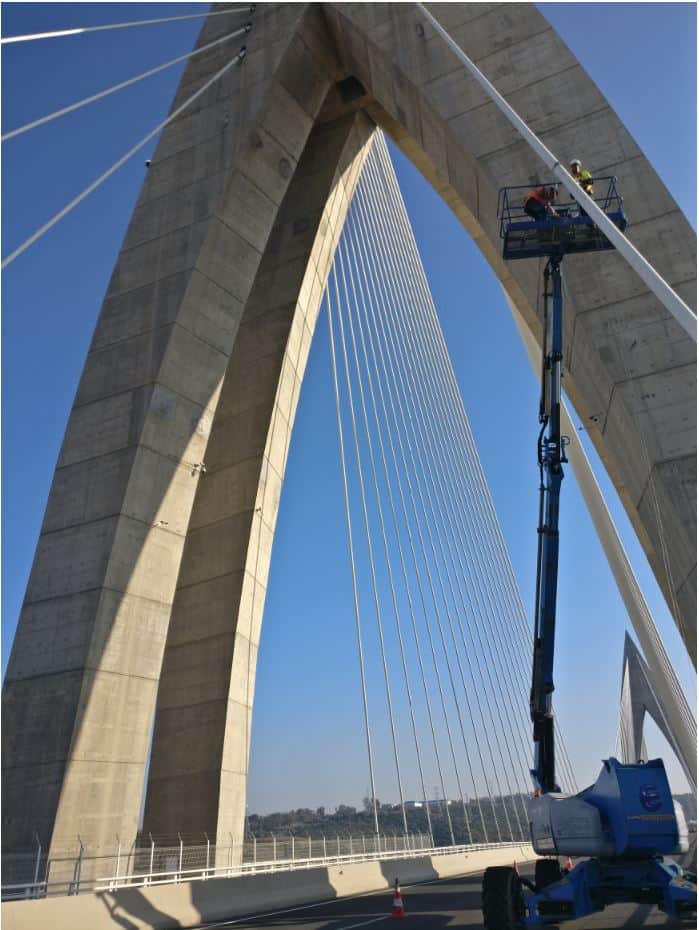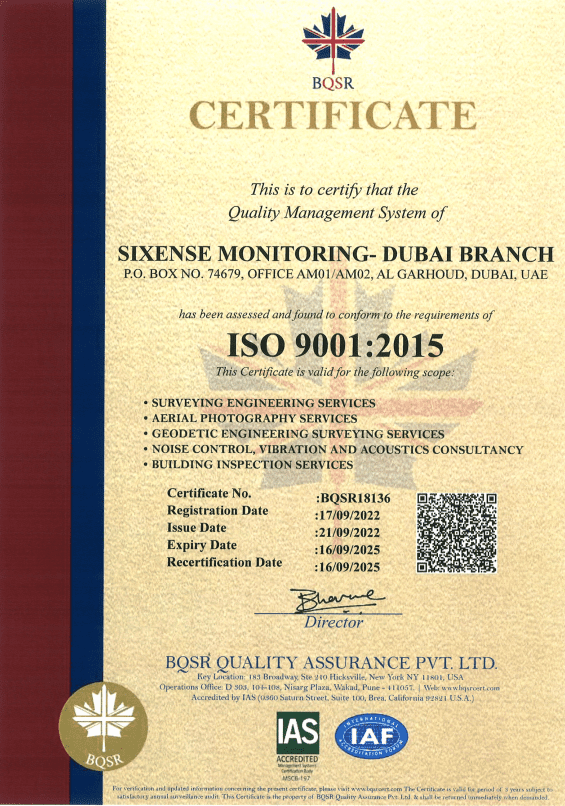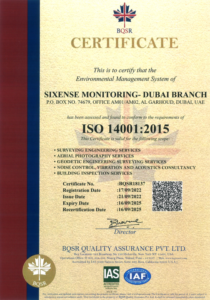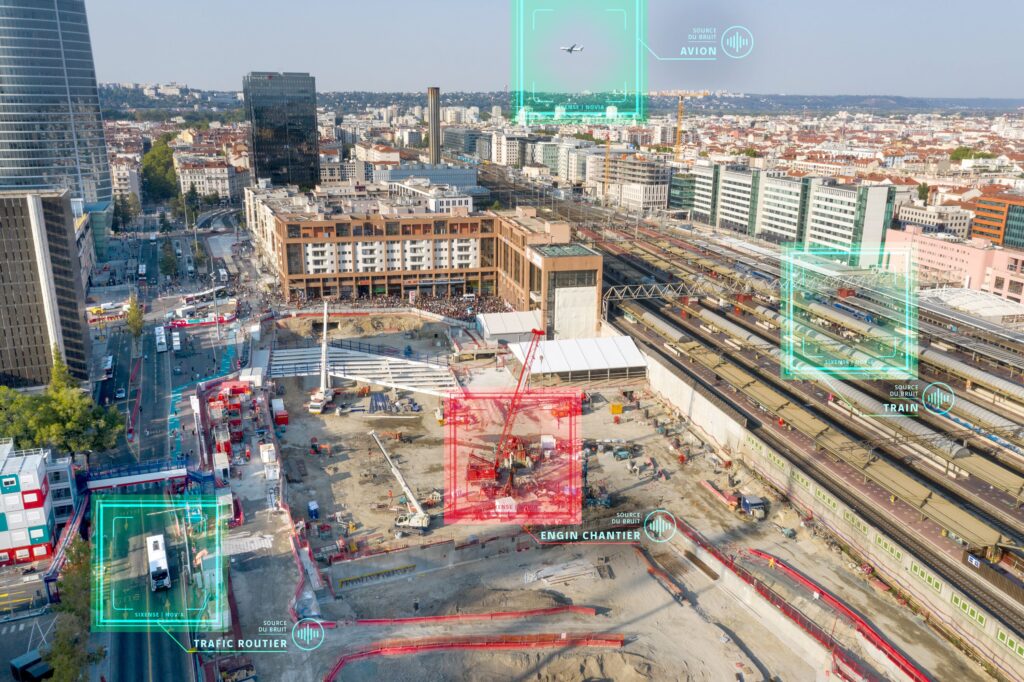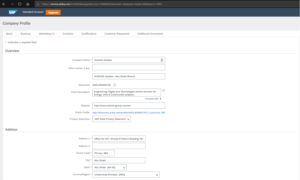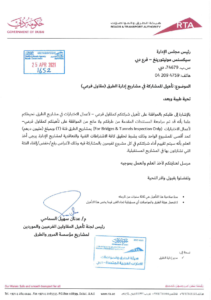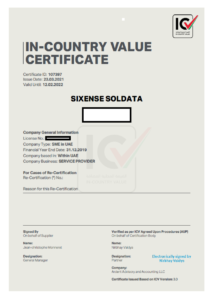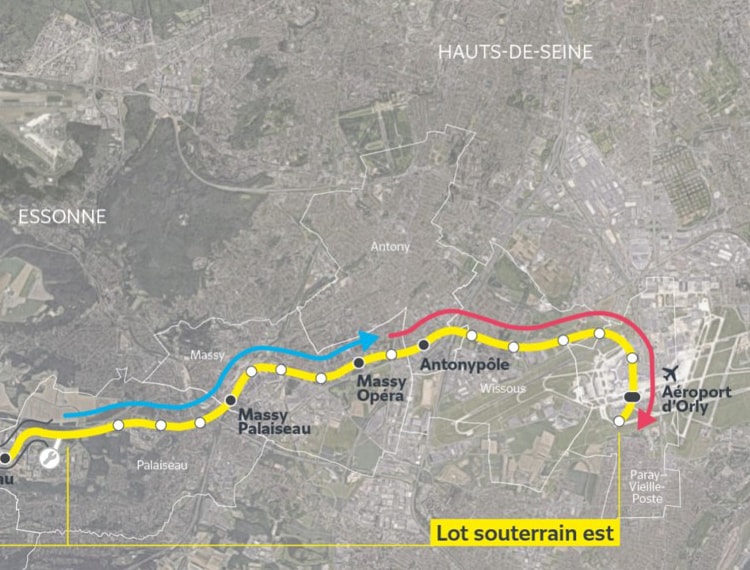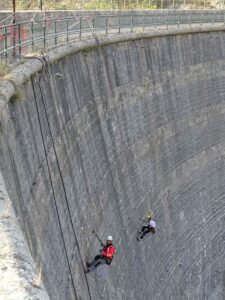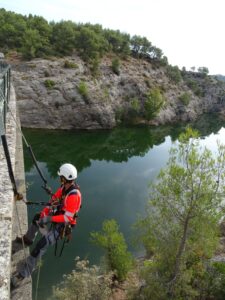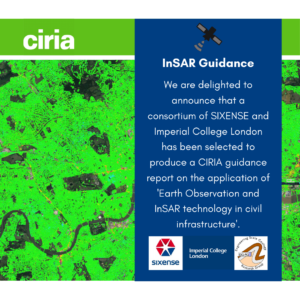With the holy month of Ramadan upon us, the Sixense team would like to extend sincere wishes for a Ramadan Kareem to our employees, our clients, and our partners. May this month bring peace and harmony to all of us!
Archives: Actualités
Yesterday, Dr. Brouxel Marc, our Business Development Director, presented a training on structural condition assessment and durability analysis to our specialized engineering team in the Middle East.
This training is part of our regular learning sessions aimed to continuously reinforce all our engineers’ knowledge of structural disorders, go deeper into understanding the reasons behind them, how to visualize and analyze them using the right tools and site tests appropriately.
At Sixense Middle East, we firmly believe in continuous learning and improvement to be able to offer our clients a service of the highest quality.
As part of a serie of software solutions we are currently unveiling, Beyond InSite is designed for project managers and contractors looking to streamline the performance of their work sites through digitalization.
InSite promotes collaboration between the different actors of a project, from design to document validation in the Document Management System (DMS), execution via self-check forms, and work verifications via site observations and defects management.
This solution includes the following:
- Monitoring of non-conformities and their resolution (defects management)
- Digitization of quality and safety forms (EHS audit)
- Document Management System (DMS)
- Library for forms creation and management
- Linear referencing for linear structures
- ScanSite and dashboards
By using Beyond InSite, you will gain access to a user-friendly interface accessible to all team members, resulting in improved productivity and project quality. Eliminate the need for repetitive data entry and streamline processes while ensuring data security and traceability. Additionally, users will have the autonomy to use the platform with Partner status.
When partnering with Sixense, take advantage of our newest solutions and benefit from digitization for managing your work sites.
What a success! Congratulations to all who contributed to making EGYPS – Egypt Petroleum Show 2023 such a thriving moment for the industry.
Our team had the opportunity to connect with many of you. We were impressed by the level of interest in our services, and we’re grateful to have made some interesting new contacts on various projects.
It’s always a pleasure to visit Egypt and meet with our local partners. We look forward to continuing to work together in the future!
Today marks the opening of EGYPS 2023 in Cairo, and we are thrilled to be here!
The energy sector is constantly evolving, and it’s exciting to discover the solutions and strategies currently reshaping the global energy markets.
We’ve had the opportunity to visit truly interesting booths and engage in meaningful discussions with industry leaders.
The atmosphere here is electric, and we look forward to connecting with you. We’d love to schedule a time to discuss your current projects and how we can support your activities.
Exciting news for our clients!
We are thrilled to present Beyond Asset, a management tool that helps you digitalize the information of all your assets.
Beyond Asset is a powerful tool for managing and optimizing the maintenance of your infrastructures. Using data centralization will allow you to organize and monitor:
– your infrastructure visits,
– overall asset ratings,
– and maintenance operations.
With Beyond Asset, facilitate decision-making to optimize and plan maintenance, as having real-time data on your asset condition enables operations performance, data security, and cost-saving.
Our solution is tailored to meet the specific needs of your business. It offers:
– Infrastructure tracking and intervention traceability,
– Updates from the field without re-entry,
– Business expertise in infrastructure management,
– Decision support for all your interventions,
– Automatic reporting and statistics.
When working with Sixense Group, take advantage of our digital products and benefit from digitization for your infrastructure management.
Follow us for more information on our upcoming software solutions.
It was a night to remember as we celebrated the end of 2022 with our annual team event at the Palazzo Versace Dubai.
We would like to thank MENARD Middle East & Central Asia, who invited us for a night of festivity and recognition of our hardworking teams.
We also used this opportunity to announce that Skreekumar Harikumar is our Employee of the Year, and Sreenivas Musku has been awarded the Safety Award of the Year for 2022!
Skreekumar and Sreenivas have consistently gone above and beyond, representing our company values and making a significant impact on our teams.
We are proud to have them as a part of our team.
It’s hard to believe that it’s already been a year since we opened Sixense Middle East‘s branch in Saudi Arabia! Under the leadership of Kamal Tahri, the team has grown from three employees to a strong team of ten, covering not only Saudi Arabia but also Bahrain.
In just one year, the team has accomplished a number of key projects. It has been extremely encouraging, and we believe it demonstrates Sixense Middle East’s ambition to thrive in the Saudi Arabian market.
We are so proud of everything the team has achieved, and we can’t wait to see what the future holds for Sixense in Saudi Arabia.
Discover our Business Suite ‘Beyond’:
At Sixense Middle East, whether you are a worksite manager or a high-level decision-maker, we have the services, expertise, and digital solutions to support you. Our teams are dedicated to helping you increase your performance through innovative, data-driven solutions.
Our Digital division has thus developed our ‘Business Suite Beyond,’ organized around 3 software with specific applications:
– Beyond Monitoring: to manage project data
– Beyond Asset: to manage infrastructure operations
– Beyond InSite: to optimise worksites performance
These powerful tools enable you to optimize your worksite operations and confidently streamline your decision-making process in real time.
We will detail our Business Suite Beyond in the upcoming articles, so don’t forget to follow us to get all the updates!
Our tool, crossbow, is often used to conduct asset maintenance campaigns and is one of our main tool for studying the robustness of prestressed structures.
Actual tension in post tension cable is an important factor to have an indication about its remaining life.
At Sixense, in order to obtain this tension, we perform what is called the ‘Crossbow test’. It will allow us to compare the actual tension with the designed tension of the cable. In case of potential defects present in the strands, such as rust signs in the wires for instance, obtaining the actual tension shall allow to determine whether such defects are affecting the functionality or integrity of the cable.
While a window needs to be opened to reach the strands, one of the considerable advantages of this test is that it keeps the integrity of the post tension cable’s strands and wires intact. None of the wires of the strands shall be damaged during this test.
Sixense Middle East acquired its own Crossbow over a year ago and our client’s projects greatly benefited from it, as references of projects in which this method was applied includes:
● Four bridges of Sheikh Isa Bin Salman Highway in Bahrain, 2021
● The post-tension cables on girders in Dammam, Saudi Arabia, 2021
● The pedestrian bridge on the third ring road in Mecca, Saudi Arabia, 2021
● The Alba bridge in Bahrain, 2022
Developed by Sixense Group, this tool offers unique opportunities and brings exclusive data to our clients. If you would like to learn more about it, do not hesitate to contact us.
As we enter the new year, we would like to take a moment to reflect on all of our achievements in 2022. On your side, it has been a year of growth and success, particularly in the UAE and Saudi Arabia, where we have firmly established ourselves.
We are very grateful to our dedicated team members and partners, who have greatly contributed to our success and allowed us to achieve our goals.
In 2023, we look forward to continuing our expansion in the Middle East region, focusing particularly on Egypt and Kuwait. We also plan to maintain and further grow our presence in Saudi Arabia and focus globally on expanding our activities within the energy sector and its infrastructures.
We are confident that hard work and determination will help us achieve even greater success in the coming year.
Happy New Year to all, and we wish you a bright and prosperous 2023!
We would like to send our best seasonal greetings to all our dear colleagues, clients, and partners.
We wish you and your family a peaceful, joyful, healthy, and merry Christmas!
A major tunnel upgrade and excavation project
The existing Kitchener Corridor with three (3) live rails are in the City of Toronto, Ontario, next to Toronto Pearson International Airport. To bring more frequent service to GO Transit customers, Metrolinx and Infrastructure Ontario started a twin tunnel construction in 2018. This infrastructure upgrade is taking place less than three metres underneath Highways 401 and 409 – all without disrupting the continuous traffic flow above.
Sixense provided a tailor-made monitoring solution in a challenging environment
Sixense was chosen by Toronto Tunnel Partners (TTP), a joint venture between STRABAG Inc. and EllisDon Civil Ltd. to perform environmental, geotechnical and structural monitoring of the existing rail tunnel and twenty-one (21) lanes of live highway, 401 and 409, one of North America’s busiest highway corridor.
In order to achieve the required high spatial density, high frequency monitoring while minimize interruptions of existing highway traffic and manual readings in heavy traffic areas, an innovative near real-time deformation monitoring system was designed and implemented. It consists of 8 Sixense’s Centuar automatic motorized total station (AMTS) with over 450 reflector-less points on the highway and 3 AMTS in the existing rail tunnel, complemented by Shape Arrays, In-place Inclinometers, Piezometers, Tiltmeters, Vibration and Noise Monitoring.
Completion of a milestone for the project
On January 22, 2021, the project reached a big milestone by successfully finishing the second tunnel excavation. Sixense’s expertise and dedication to the continued success of the project is well recognized by the project team. The new tunnels support the GO Expansion program and will transform the Kitchener line to a more convenient two-way, all-day train service.
ISO Dubai
ISO Abu Dhabi
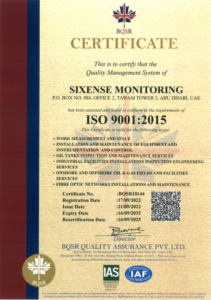
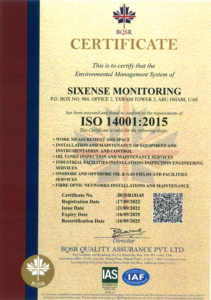
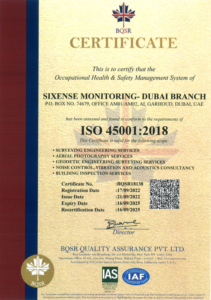
ISO KSA
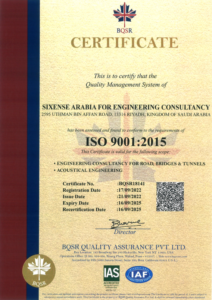
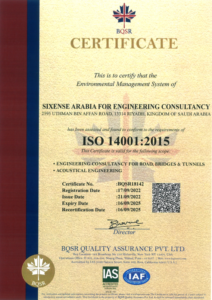
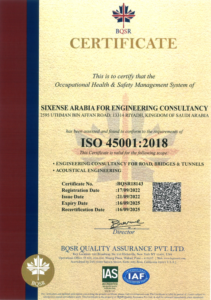
ISO Certification:
Sixense is part of the VINCI Group, and therefore inherits from and takes part in its QHSE Culture.
We bear in mind that our most valuable assets, our employees, along with other stakeholders and third parties, have the right to work in a healthy and safe environment.
We, Sixense, recognize the importance of protecting our staff and strive to promote a positive attitude to working in a safe environment and have a clear commitment to safety matters. We also recognize the importance of preserving the environment and the right of the future generations to an environment in which they, in turn, can sustain a high quality of life.
At last, we believe that an effectively operating Quality Management System and the pursuit of business success are inextricably linked. It is therefore our primary responsibility to maintain highest quality management standards.
There is no better way to set our engagements than by committing to follow the recommendations of ISO9001, 14001 and 45001, for which we are proud to be certified.
ISO certification certifies that a management system, manufacturing process, service, or documentation procedure has all the requirements for standardization and quality assurance.

Emirates International Accreditation Centre (EIAC) mains activities are to accredit Conformity Assessment Bodies (CABs), both Governmental and Private, within the UAE and overseas, including Laboratories (Testing, Calibration and Medical), Inspection Bodies, Certification Bodies (Management System, Product Certification and Personal Certification), Halal Conformity Assessment Bodies, Proficiency Testing Program Providers, Reference Materials Production Activities, Validation and Verification Activities.
At the beginning of the month, the Project Managers of all business units gathered in France to participate in a Project Management Plus training.
This training not only aimed to increase our expertise in Project Management, but also to bring every actor behind Sixense Group closer to each other!
This was a great opportunity for the team to reconnect, catch up, and learn more about what’s happening within our company.
The development of Earth Observation techniques
Earth Observation covers a wide range of technologies that have come of age throughout the past two decades and are expanding into a new era of cloud processing, very high-resolution and near real-time service delivery with the use of spaceborne data within infrastructure asset management.
The launch of the new CIRIA guidance report
We are delighted to announce that the new CIRIA (Construction Industry Research and Information Association) guidelines on Earth Observation and InSAR technology in civil infrastructure is now available.
Produced by a consortium led by Sixense and Imperial College London, the guidance report improves accessibility to Earth Observation technology by understanding techniques and products applied to infrastructure management.
What you will learn about ?
The report draws on the extensive experience of the consortium members and detail current practices, illustrated with case study examples, and outline respective advantages and limitations of the various techniques to assist all users and in particular those involved in asset management and construction. It forms an important step towards establishing the use of Earth Observation techniques as a matter of ongoing best practice for asset management in civil infrastructure projects.
Follow the link below to order your copy:
For more information, please contact satellite@sixense-group.com
As our activities expand in the UAE and the Middle East region, we expect to reach ambitious targets next year and join large infrastructure projects directly supporting the area’s development.
In these circumstances, we must put even more care into our recruitment strategy to meet our needs, maintain a motivating work environment and constantly enhance the services we provide for our clients.
Our two last additions to the teams are talented commercial engineers, and we are excited to work with them to reveal their full potential.
Raymond Serhal recently graduated with a BE in Civil Engineering from the Lebanese American University in Beirut.
“I look forward to my first professional experience! I am glad to be in a polyvalent position that will allow me to widen my knowledge in many expertise.”
Previously, Moustafa Elsisy was an architect and fit-out engineer for four years. His diverse experience will be a determining asset for Sixense.
“I look forward to learning more, expanding my knowledge, and taking further steps in my career alongside Sixense’s success.”
Welcome on board!
We want to thank MENARD Middle East & Central Asia, our sister company, and Ahmed Hussam for their warm welcome during our team’s trip to Kuwait last October.
Ahmed NADA and Mirella Khalil had a constructive stay in Kuwait, studying the area, meeting local actors, and understanding its challenges.
Discussions during business trips in other countries are essential for Sixense, as it builds the ground for productive and balanced relationships with major contractors, government entities, and consultants.
We are excited about these new projects and opportunities in Kuwait, a country that has always occupied a special place in our strategy due to its high potential.
Stay tuned!
On the 19th of November, the 2022 FIFA World Cup began in Qatar. For 28 days, the best football teams will compete for a coveted trophy.
It is the occasion for the Sixense team to look back on one of their key projects in Doha as the city reinforces its transport system, develops its metro network, and improves mobility for all.
Sixense was selected to provide instrumentation and monitoring services on the Red Line North, covering more than 40 kilometers through the city. We dispatched ten survey teams and 15 engineers to Doha, who immersed themselves entirely in the project and worked intensively for four years, performing up to:
– 6,000 leveling points (settlement markers and precise leveling points)
– 2,500 optical prisms
– more than 20 geodetic monitoring (Cyclops Solution)
This large-scale project also required the use of 300 geotechnical instruments and the deployment of more than 1,000 structural sensors on sensitive structures during the drilling and construction.
We are glad that our expertise participated in constructing a vital transportation network for the city while minimizing all risks, as we did in similar projects in Dubai and Riyad.
As leaders of the entire world gathered in Egypt for COP27, we took the time to put into question our relation to the environment.
In October, on International Environmental Day, VINCI Construction invited all its entities to conduct environmental actions in their respective locations.
At Sixense Middle East, we first decided to invite all our associates to a webinar to raise awareness about the challenges of waste management and brainstorm on the topic as a team.
We then organized a beach cleaning at Al Sufouh Beach to support the non-profit association Project Rescue Ocean.
We appreciated this time dedicated to such a particular cause, and it gave us time to reflect on our impact on the environment in our personal and professional lives.
Last night, our team gathered at McGettigan’s for a relaxed quiz night altogether. It is also the occasion to welcome and get to know two new coworkers who recently joined us better.
We are delighted to introduce to you Danna Jane Murillo Murillo, our new administrator, and Sanal Sankar, who will join us as a project engineer.
Danna has an incredible record, working in Dubai for seven years as an admin and accounts assistant in the trading and I.T. industry!
“It’s time for my next challenge. I am thrilled to be part of the growing success of Sixense Middle East as the new Office Administrator!”.
Sanal has a long experience working in the Middle East as a survey engineer, a site engineer, and a facade designer! We are glad to welcome such a multi-skilled new colleague.
”I worked very hard and was patient enough to get to this position.”
After an evening full of suspense and laughs, punctuated by questions on music, food, general culture, and knowledge about Sixense, let’s announce the winning team.
Congratulations to Silviu Dobroiu, ANAM AYOOB K P, Sanal Sankar, and Elmer D.! Our special prize for the winners is a voucher from Mall of the Emirates.
Sixense thanks you all for your participation and efforts. Until next time!
On the 20th of November, the Yas Marina Circuit will host the Formula 1 Etihad Abu Dhabi Grand Prix 2022!
With a seating capacity of 60,000 people, the circuit is the second Formula 1 track in the Middle East and one of the most active sports venues in the region.
A few years after its opening, Sixense was selected to support the construction of pedestrian tunnels under the race track. As dewatering activities were required, our teams continuously monitored the settlements’ movements using our Centaur solution. This solution measures the ground settlement without requiring installing anything on the ground.
We are excited to follow the season’s final race on the 20th of November.
The Kifaf Development is another exciting landmark project located in the emerging Zabeel district in Dubai. It will include two iconic tall twin towers connected by a bridge in the shape of the number “1”.
We were happy to work on this ambitious project in the middle of Zabeel, one of the busiest areas of Dubai. Our teams got involved during the enabling works, then installed Sixense’s classic monitoring techniques, focusing primarily on shoring walls.
Our real-added value on this project was a live automatic monitoring system for shoring walls and the close-by DEWA power station, especially during excavation works. Our solution also included an alarm system and live access to the data through our software Geoscope.
Throughout the different stages of the construction, our teams provided complete and regular engineering consulting assistance to the contractor. We are excited to see the opening of the Kifaf Development as it becomes one of the driving projects to further develop this area of the city.
After a fantastic, inspiring, and motivating few days, ADIPEC ended on the 3rd of November.
Many thanks to the French Pavillon for welcoming Sixense and its teams.
Many thanks to the corporate participants and the numerous visitors who filled these four days with fruitful discussions and unique synergies.
Finally, we want to congratulate the other companies at the French Pavillion, who represented France on our side and enabled an atmosphere prone to exchanges.
Join us at ADIPEC 2022!
10 Days To Go. Sixense is proud to be part of the French Pavilion at ADIPEC 2022 representing the French know-how.
Join us at Stand 9232.
The Gulf region is subject to extreme environmental conditions. High ambient temperatures, salt-contaminated dust, seawater, and other factors significantly impact the lifespan of local infrastructures.
At Sixense, our mission is to accompany our clients throughout the entire life cycle of their buildings, even in the most extreme conditions, which means assessing and managing the durability of structures.
While repairing a bridge involves closing and diverting traffic, impacting the local economy, and facing high reparation costs, understanding and controlling the durability of buildings allows us to improve it and reduce repair costs directly.
Our durability assessment includes a comprehensive investigation of the structure’s condition based on the:
general visual disorders,
site investigations coupled with destructive/non-destructive testing,
laboratory tests.
The results are then analyzed to diagnose the expected remaining service life of the structure and advise on any maintenance to enhance it.
The Geoscope database, installed for the Data Acquisition and Management System (SAGD) of the ANDRA underground research laboratory of Bure (France), celebrates its 20th anniversary this summer.
The Geoscope database was created on Thursday June 13, 2002
The first acquisition point PPA0005_DFO_01 was created on June 26, 2002.
Today this database is still working and holds the world record of the largest Geoscope database with 9 billion values (9 228 800 000 values on the 20th anniversary).
The number of sensors is 30 000, and the database size is 1.34 Tb.
Geoscope / Beyond Monitoring is Sixense platform for management of monitoring data. Continuously developed and improved since 1997, it is used successfully on monitoring sites worldwide, from mega projects to small 10 sensors locations.
ANDRA is the French National Agency for Radioactive Waste Management. The Bure laboratory is a network of horizontal underground galleries dug at a vertical depth of 500 m beneath the surface. It is used to evaluate the containment properties of the geological formation, in view of a potential future nuclear waste storage (CIGEO project).
The ANDRA Meuse/Haute-Marne research center in Bure (55)
The Bure Laboratory, or the Meuse/Haute-Marne Underground Research Laboratory, is a network of underground galleries located 500 m deep under the territory of the municipalities of Bure (Meuse) and Saudron (Haute-Marne) in France.
As part of research on the storage of radioactive waste in deep geological layers, this underground research laboratory is operated by the National Agency for Radioactive Waste Management (ANDRA) in order to assess the confinement properties of the geological formation located at a depth of 500 meters, in view of a potential future CIGEO nuclear waste storage project.
On the surface, a network of piezometric drillings and environmental monitoring stations record natural parameters.
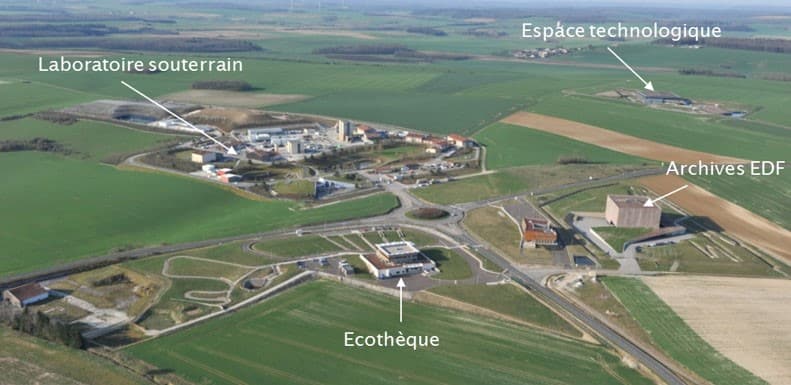
Data Acquisition and Management System
The Underground Research Laboratory hosts several dozen types of mechanical, thermal, chemical, hydraulic, short and long term experiments, carried out by researchers from the laboratory but also various external French and foreign laboratories, and private companies selected through specific calls for tenders.
The measurements are therefore of all types, all frequencies, all formats.
Aware of the crucial nature of measured data, ANDRA issued a call for tenders in 1999 to design an instrumentation and monitoring database (which would today be called an instrumentation and monitoring platform), with the following priorities:
• Data security requirement, among the thousands of measurements carried out in the laboratory, none must ever be lost or modified, all the raw measurements must be kept and protected without any modification.
• Consequently, computer security requirement, secure and differentiated access, by research entity, by experimentation, by sensor.
• Requirement for processing power and ease of use and ergonomics, to help researchers extract the maximum information from the measured data.
• Requirement of durability over time, of permanent evolution to follow and survive changes in computer hardware.
Sixense Monitoring (then called Soldata) offered its existing Geoscope solution. Geoscope is the monitoring platform used by Sixense teams around the world for their own instrumentation and monitoring services. ANDRA’s requirements are guaranteed, among other things, by the fact that our teams have the same needs every day.
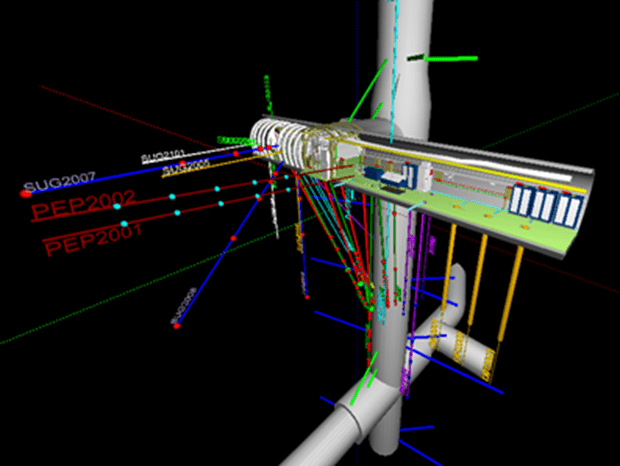
In 2022, in the continuity of the permanent evolution of its solution, Sixense launches the Beyond Monitoring platform, direct successor to Geoscope:
Geoscope database statistics (June 2022)
Database size: 1.34 TB
Size of a full database backup, after compression: 120 GB
Number of measurement points: 29,190
Number of values measured: 7,990,623,000
Number of values calculated: 1,238,177,000
Number of alarms: 2,627,587
Number of daily summary values: 53,038,329
Number of hourly summary values: 1,125,941,000
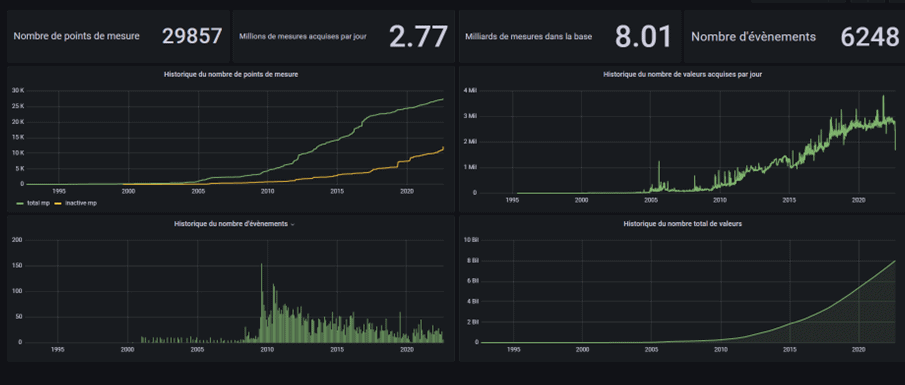
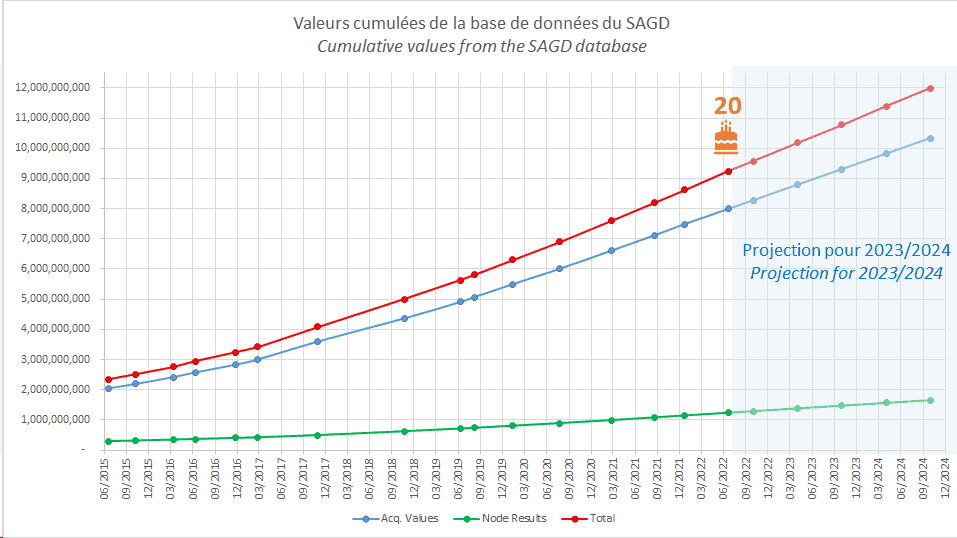
Sixense’s expertise covers the analysis of all types of structures, and our teams are used to assess the condition of the largest infrastructures but also old and new buildings. Sixense is, in fact, regularly solicited for its expertise in fire investigation.
Fires are a real challenge for Dubai’s resident[SA1] s. According to the Ministry of Interior, 2 090 fire incidents happened in homes and facilities in 2021, of which 66.2% were residential. More than 50% of these fires supposedly occurred in reinforced concrete structures.
After these incidents, Sixense is often involved in many post-fire investigations and recommendations for repair solutions. The exposition of materials to very high temperatures can alter their properties, and it is essential to create a damage mapping and conduct tests and surveys on the affected areas. This way, we can assess the structure’s state and safety and the extent to which it should be repaired.
Riggat Al Buteen is located along Dubai creek in the East part of the city. As one of Dubai’s oldest districts, the area contains historical residential developments displaying traditional and modern architectural styles and the popular Deira shopping center.
Sixense was contracted by Dutch Foundation to support the construction of a residential building with 16 floors and two basements in the heart of this sensitive location. As for any excavation in such a dense urban situation, instrumentation and monitoring were mandatory.
This type of service is very classic in the construction industry. Using sensors, and our automatic total station, Cyclop, our teams demonstrated Sixense’s ability to support and advise our clients in highly technological and complex projects, but also more basic ones. High-quality fundamental analyses allow you to move forward and make the most challenging things possible.
Jean-Christophe Monneret, the General Manager at Sixense Middle East, and his team had a busy summer in Cairo.
Recently, Egypt has embarked on major infrastructure projects, expected to shape a new future for the country. Train lines, roads, bridges, housing units, and even a New Administrated Capital are now the government’s priority to boost the economy and solve traffic congestion in Cairo. As the country continues to work on these exciting projects, we look forward to supporting change with Sixense’s expertise.
During our regular trips to Cairo, we are always glad to connect with more local authorities, consultants, contractors, and independent decision-makers hoping to build sustainable long-term relationships and partnerships. If you’d like to meet face-to-face, feel free to contact us.
Monitoring of the structural health of the largest suspension bridge in the world in Turkey
An exceptional structure
Sixense’s Monitoring division works on an extraordinary structure in the Dardanelles Strait: the 1915Çanakkale bridge, which the Turks call the “1915 Dardanelles bridge”, in reference to a naval victory for Turkey. This suspension bridge has the longest central span in the world: 2,023 meters, in homage to the centenary of the foundation of the Turkish Republic.
What are the particularities of this structure?
In Turkey, 400 km southwest of Istanbul, the Dardanelles Strait is the only access between the Black Sea and the Mediterranean Sea. It is there, near the city of Çanakkale (former city of Troy), that the 1915 Çanakkale bridge stands and was inaugurated at the end of March 2022.
This 3,563-meter-long suspension bridge is made up of two pylons 2,023 meters apart supporting a 45-meter-wide deck, through 2 cables and its suspension.
The structure was built by a consortium of 2 Turkish companies (Limak and Yapı Merkezi) and 2 South Korean companies (DL E&C and SK ecoplant). Sixense has been selected by this consortium to design, manufacture and install an exceptional instrumentation system with more than 1,000 sensors… a world premiere!
How will the Sixense SHM system help optimize bridge operations?
These 1,000 sensors will provide a continuous view of the multiple behaviours of the structure in relation to stresses to which it will be subjected. The system will provide information on deck and cable vibrations, stress concentrations in the mechanical elements, temperature at various points on the structure, weather and seismic information, and the concentration of traffic on the structure.
The data is accessible in real time on the Sixense monitoring platform.
Much more than a visualization of phenomena, the system put in place by Sixense will allow scenario predictions by varying the environmental parameters of the structure. Thus, the operator will be able to estimate the aging of the structure according to its traffic increase predictions.
Volume calculations are essential in mining and quarrying. It helps calibrate equipment and teams, produce accurate reports and undergo regulatory checks. The measure is usually done by conducting on-site surveys using leveling machines or total stations. But drones are the most efficient solution available.
Those who introduce drones into their #mining and #quarrying operations quickly realize the significant added value they bring to the industry and how they contribute to the overall efficiency of any site.
– Timewise: Drones will need ten minutes to complete a measurement mission, compared to five days for land-based methods.
– Accuracy-wise: Drones are five times more precise than other methods, providing accurate and comprehensive data detailing the site conditions.
– Cost-wise: The use of drones represents a marginal cost difference.
This powerful solution is a game-changer for mining and quarrying but also other delicate operations such as:
– Structure inspection: to avoid scaffolding
– Precondition survey: to gain time and efficiency
– Quay wall, wave breaker, and seashore monitoring: to refrain from using boats and heavy equipment
We had a busy week in Cairo, meeting local authorities, consultants, contractors and independent decision-makers involved on the many exciting projects that are re-shaping the country. We will be coming back and look forward to building sustainable long-term partnerships in Egypt.
At every stage of your project, monitoring ground deformation and structure stability is essential to maintain the quality and safety of your operations. Therefore, we would like to introduce InSAR, our satellite monitoring solution.
Topographic surveys are usually done manually or by using a total station. However, none of these alternatives matches the efficiency, millimetric precision, and convenience of InSAR.
– Traditional measurement methods usually monitor the displacements of precise points in an area, whereas InSAR monitors the entire surface, using millions of measurement points in a reduced time lapse. While very high-resolution results, our solution’s deployment only takes two days compared to other methods that require seven days.
– Through satellite images, InSAR captures the details of a whole area simultaneously, with unique accuracy. You can also compare current pictures to previous ones (up to 30 years ago) and better understand the area’s ground motions.
– As a remote sensing technology, InSAR doesn’t require any onsite intervention to provide results. This service allows quicker, cost-efficient, and reliable risk management of your projects.
Next time you think about large-scale monitoring (railways, pipelines…), look at the stars and think InSAR. It’s a no-brainer.
Thanks to Sigma and Mazrui International for inviting us to an amazing Networking event in Abu Dhabi and getting the opportunity to meet interesting oil and gas players within the group.
A sustainable infrastructure also means a more resilient one. For that matter, we asked Bunafsha Mislimshoeva, Head of International Projects Development at Resallience (our design office specialised in climate resilience), to explain more about this concept and how we can build more resilient transport infrastructure projects, in the context of an everchanging climate environment.
Let’s see what our expert Bunafsha has to say about this. ?
? Could you please explain to us the importance of building a more resilient infrastructure? Please provide us with a bit of context: where does this urgency come from and why now?
? What does building climate resilience actually mean?
? How do you see the degree of preparation of other countries regarding the subject of climate resilience? Is Europe ready to act or has it already started planning?
Mines and quarries are sensitive facilities where risk can impact employees and local communities. At Sixense, we believe monitoring in this industry is essential and have developed dedicated solutions based on our experience worldwide.
As one of the largest limestone quarries in the world, Khor Khuwair has no room for error and requires continuous and accurate monitoring. We thus decided to deploy the Cyclop system combined with a unique geotechnical and structural expertise.
But each mine and quarry faces different challenges, and our mission is to choose and adapt our Mine & Quarry solutions to specific needs wisely. Discover some of our products below:
● Cyclop system, providing a constant automated 3D monitoring
● Atlas InSar, a remote radar allowing measurement of ground deformation and structure stability from space with millimetric precision
● Drone surveyors, able to evaluate the excavation volume in real-time
● 4D Skin, providing remote millimetric monitoring of rock instabilities over large areas
● Mining pit monitoring solutions
In the coming weeks, we will share more about our Mine & Quarry solutions.
Stay tuned and follow us on LinkedIn to learn more about how our solutions can solve your problems.
As part of our Mine & Quarry serie, we would like to introduce our contactless radar technology, 4DSkin. Developed through 20 years of experimentations, it is a simple and optimal solution for large-scale, high-frequency, high-accuracy monitoring.
4D Skin offers remote millimetric monitoring of rock instabilities over large areas and structures such as quarries, dams, hills, and cliffs.
Because accuracy doesn’t have to equal complexity, the set-up only takes a few hours. It will give you an accurate measurement (typically 0.2 mm) of large areas (up to 4 kilometers) in any weather. It can even assess the risk of landslides without directly accessing the location.
The unique features of 4DSkin were chosen to monitor a dangerous cliff in the French Alps throughout a construction project. The steep section spread over almost 8000 square meters, and high precision measurements were necessary to detect any unstable rock over 2 to 3 months. Every two minutes, 4D Skin scanned the entire area, triggering an alarm in case of movement speed greater than 3mm/hour on surfaces of 10m2.
Thanks to artificial intelligence, Sixense has developed the Novia solution to answer one of the major questions on your worksites: “Is the excessive noise level caused by my on-site work or not?”. This solution, based on the machine learning technology, allows to identify whether or not a particular sound emanates from your construction noises or the surrounding urban activity.
Accessible via our Geoscope interface, Nora allows you to reduce the risks of complaints, site stoppages or even penalties. The Novia function can be activated at any time on all standard monitoring systems and automatically adapted at each phase of the construction.
This gives you a clear and transparent mean to justify a good noise management on your worksite to your clients and authorities.
If you are facing noise issues on your worksite in a sensitive urban environment, get in touch with our expert Karim Benaguid for more information.
Discover our solution in detail here.
Our solutions implying drones can make you save significant time and effort when managing your assets.
#Drones have numerous applications, from assets and #risk management to construction and consulting.
At Sixense, we have a long-standing experience using these technologies to inspect structures, gather data, and present you with a diagnosis and recommendations.
Discover our range of solutions:
– Inspection: Drones enable us to access remote areas to complete an accurate assessment and operate more quickly afterward if needed. For example, our drones can help identify leaks using thermal cameras or structural disorders using an orthophoto.
– Digitization: Digitizing your assets is an essential step in every project. With the #mapping function of our drones, we can recreate a 3D high-quality digitalized image of your #infrastructure in a short amount of time. For example, the #scanning of a quarry is enough to assess the excavation volume.
With drones, our teams can operate quickly, gather accurate #data, and formulate the ideal solutions for your particular situation.
Deira initiates its transition into a new chapter with its waterfront development.
The proximity of the construction zone with the green line metro, the Al Shindagha tunnel, the seaside, and the necessity of using shoring walls for the #excavation works, makes it a complex project with critical challenges.
Flexible expertise and an extensive range of solutions allowed Sixense to become a vital problem solver partner for this project, carrying on fundamental operations.
– Monitoring of the metro rail movements during the construction using our “Cyclops” system to gather and analyze real-time data.
– Continuous assessment of vibrations, cracks, tilting, and strains using vibration units, crack-meters, #tiltmeters and strain gauges.
– Involvement in the shoring process using sophisticated real-time daily monitoring of the retaining walls.
By working at night, our teams could deploy the necessary solutions with a minimum impact on the numerous users of these infrastructures.
As the region takes action to develop freight and passenger rail transports and integrated transportation services through massive investment, the monitoring of rails has more than ever become a significant safety matter.
Last month, we had the pleasure of attending the Roads & Traffic Expo for innovation, technology, and infrastructure hosted by Etihad Rail in Abu Dhabi. This was the occasion to demonstrate Sixense’s skill set when it comes to the monitoring and preventive maintenance of rails.
“Rail Serenity” is a solution package focused on rails monitoring. It has been developed by our teams using two of our existing and proven technologies:
· Cyclops, a prism measurement system
· Tiltmeter sensors, monitoring the movement on the rails’ foundations
This combination uses measurement redundancy and allows for continuous measurement regardless of the weather conditions and trains’ location on the tracks.
“Rail Serenity” is not only a new product, it is built on years of experimentation, customers feedbacks, and crossed expertise. It ensures safe, and trouble-free operations on rails through constant monitoring and reliable filtering of possible false alarms.
In June, the commercial teams of all business units, and our solutions experts, will be gathering to spend a few days together in France. This seminar aims to bring every actor behind Sixense, closer to each other and increase our entire expertise as a global company.
Internal communication and teamwork between our offices worldwide is the key to our skillset. As we network, reconnect, catch up, and develop our relationships, we also expand our knowledge of Sixense’s solutions and our capacity to meet our clients’ needs.
These few days in the French countryside will be dedicated to learning more about what’s happening within our company, what has previously been done elsewhere, and how each of us can benefit from others’ experiences.
At Sixense, we believe that the key to successfully applying our solutions is the human factor. This is why the sharing of unique know-how, the maintenance of relationships, and the continuous improvement of our teams are a top priority.
Sixense Middle East was contracted to perform a comprehensive site inspection and evaluation of the post-tension (PT) cables of 4 crucial prestressed bridges in Bahrain.
Sixense Middle East, with its expanding presence in the GCC region, completes work on Jasra Grade Interchange Reconfiguration, a project for the Ministry of Works in Bahrain.
The role Sixense played was to undertake a comprehensive site inspection and evaluation of the post-tension (PT) cables of four crucial prestressed bridges, the Janabiyah, Sehla, Tubli and Umm Al Hassam bridges. The bridges are all strategically located along the Sheikh Isa Bin Salman Highway, which leads from the kingdom’s capital, Manama, to Dammam through the King Fahd Causeway.
Sixense’s role was to provide data obtained from the site inspection, using high-end non-destructive tools, to assist the client in completing the structural analysis and assessment of the bridges. Sixense provided timely, cost-saving, information for preventive maintenance to ensure bridge integrity for the sake of public safety.
Resallience, our design office specialized in climate resilience, won the PIARC France 2021 Award in the resilience category.
Resilience of road infrastructures to face climate change
The French Committee of the World Road Association has launched the PIARC France 2021 Awards to highlight the road and transport sector. Our Resallience teams: Philippe Sohouenou, Didier Soto, Camille Vignote and Karim Selouane, wrote a paper that won them first place ex-aequo, in the Resilience category for the Calgary congress. This is a real international recognition of their work on the technical, scientific and innovation aspect.
The paper entitled “A framework to prioritize critical road segments for climate-resilience investments” was presented by Philippe Sohouenou at the XVI World Congress on Winter Roads and Road Resilience held virtually. He spoke at the “Road Network Resilience to Climate Change” session on February 9 and at the “Poster Session 7” on February 10, 2022.
Here is an extract from the full article available below:
“With climate change, the impacts of natural hazards on road networks and mobility could worsen. Hence, strengthening the resilience of road infrastructures to natural hazards is more critical than ever before. To reach this objective, the design, operation and maintenance of road infrastructures should be informed by climate, transport, infrastructure and land-use data and models. In particular, transport operators and public authorities need to analyze such data and models to identify critical roads, which should be given priority for resilience strengthening investments. “
Sixense Mapping carried out a high density (1000 points/m²) helicopter-borne LiDAR measurement of the summit of Mont Blanc as part of a commercial scientific mission. This measurement, which took place two weeks before the “official” biennial measurement by the French chartered surveyors’ association, is the subject of a detailed article in the December 2021 issue of XYZ, the journal of the Association Francophone de Topographie (French-speaking association of topography).
The use of LiDAR for such a measurement is a first, Mathieu Peyrega, development engineer at Sixense Mapping, explains:
“This alternative method to mountaineering expeditions and conventional topographic techniques allows for a measurement of equivalent accuracy. The result, to our knowledge, is the highest density source of information ever produced on the roof of Western Europe, with an accuracy level fully equivalent to traditional survey techniques.”
In addition to the experimental validation of potentially being able to use our sensors in these extreme conditions, the obtained measurement accuracy (+/- 10cm@95%) is identical to the terrestrial methods and confirms the effectiveness of this technique. The short implementation time makes it possible to use it with a reactivity that is not possible with conventional approaches.
The results obtained, correlated with the weather conditions observed between the two measurements, bring a new perspective on the “short-term” movements of this emblematic peak, which has moved by nearly 13 meters in planimetry and nearly 1 meter in altimetry over the period. In a way, this leads to relativise the “absolute” interest of a centimetric precision measurement in this specific context.
However, for us, this remains an exceptional flight that illustrates the extent of our systems’ capabilities, our teams, and our ‘know-how’.
Over the past 10 years the Sixense teams in the Middle East have accumulated a substantial amount of experience and have played a key role on many heritage projects. With its prime proficiency, Sixense is able to provide its clients with the best monitoring and engineering and digitalisation solutions for their projects.
Sixense is really proud to have secured major contracts with clients such as government entities like Abu Dhabi Department of Culture and Tourism and to have assisted build and protect what is part of the United Arab Emirates heritage.
While providing services for the projects detailed below, Sixense carried out instrumentation and monitoring for structures, soil and environment, as well as SHM (Structural Health Monitoring), 3D mapping, condition assessments, non-destructive tests, and engineering services.
Sixense expertise applied to Abu Dhabi national treasures
One of the most prestigious projects Sixense has been working on was Qasr Al Hosn. The old residence of the royalty was undergoing renovations for its redevelopment. The aim was to better integrate it within the city by opening it to the public as a national and natural history museum. As the building was highly sensitive, it needed to be monitored in real-time to avoid damages. Sixense provided structural, geotechnical, meteorological as well as seismic monitoring. To that purpose the teams in the field used many types of equipment in order to best accomplish their mission.
In this way, they deployed a group of robotic theodolites (Cyclops) to monitor the 3D movements, tiltmeters and crackmeters on the fort walls of the structure, piezometers for the monitoring of the water table behaviour and geophones (Gorgones) to measure the induced vibration of the structure.
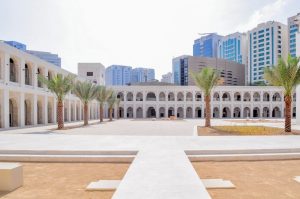
Al Ain museum, the oldest museum in the country and one of Al Ain major attractions recognised nationally benefited from Sixense expertise. As the demand for offices and storage increased, a re-design was provided to harmonise the facilities including undergrounds. This meant deep excavation would be carried out in front of the highly valuable heritage structures. Sixense was called upon to provide instrumentation and monitoring to ensure the works would go safely by ensuring the stability of the structure.
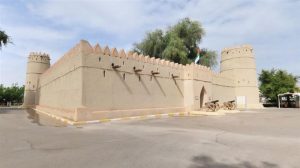
Both projects required data acquisition and a management system. Sixense designed, installed, and managed these interfaces, allowing all data to be transmitted in real time to a web-based interface. Automated alarms and user-friendly data visualization allowed the engineers to assess the performance of the structures and take quick corrective actions when necessary.
Sixense involved in Dubai’s major heritage projects
Not only Abu Dhabi needed specific expertise. In Dubai, the new Museum of the Future also required special care. This gigantic structure and unique design needed foundation works for its pedestrian bridge crossing to the Emirates Tower Metro Station. This is where Sixense came in to provide the vibration and settlement monitoring of the ground while assessing the risks and effects on the existing assets. Thanks to the quick reactivity and mobilisation from Sixense on site, the operation was handled efficiently and in a total safety.
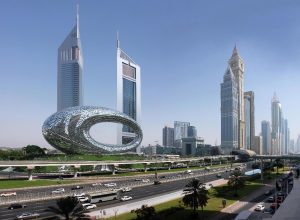
Al Shindagha Tunnel is the oldest and busiest tunnel is Dubai with no less than 55,000 motorists crossing it every day. As the only underwater road in Dubai Creek, it is of particular importance as it connects this part of the city with Al Ras, Deira and Al Shindagha neighbourhoods. Opened in 1975, this tunnel is an important asset which requires special control and maintenance.
It is for this purpose that Sixense was solicited to provide 3 different offers: Structural Health Monitoring, digitalisation, and engineering.
- Firstly, the Structural Health Monitoring (SHM) by carrying out the instrumentation and automatic monitoring activities, with real-time data for the Shindagha Tunnel. This system was set to assess, control, and ensure the stability of the tunnels during the surrounding construction activities, while some of the instrumentation aims at monitoring the deflection of the shoring wall during the execution phase of the adjacent enabling works. Shindagha tunnel I&M is meant to be permanent.
- Secondly, during the digitalisation, Sixense provided a drone inspection, as well as a 3D scanning of the tunnel with the CAMTREE acquisition device developed by Sixense to provide the highest level of assets digitalisation. Furthermore, we implemented an AI-assisted disorders detection solution called “Caméléon”.
- Finally, Sixense carried out a condition survey including a visual inspection as well as a photographic survey.
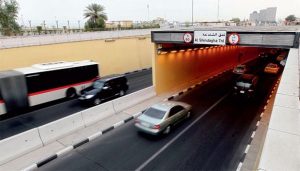
Sixense presence in the Sharjah Emirate
With two different projects for the Sharjah Art Foundation, Sixense contributed to the emirate heritage by providing engineering services. For both projects, the engineering services included on-site investigation and inspection coupled with its analysis as well as laboratory tests.
The first project, the Photography Museum, needed an investigation campaign for a structural assessment of the Building. Sixense had to provide information, on-site inspection, analysis of investigations and laboratory tests. All these steps led to essential recommendations regarding the repairs to be implemented.
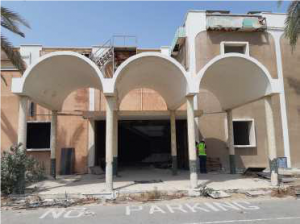
More recently our teams took up the challenge to provide job site testing and recognition of structural elements for the old Sharjah Planetarium building. The main objective was to provide a survey of the building for a relocation of the old planetarium’s dome structure. Built in the 1970’s, this monument is part of the Middle East heritage. That is why it was necessary to avoid any risk of damaging the structure before its relocation. Indeed, this area is intended to be equipped with new infrastructure which will replace the dome.

ADNOC registration :
Joining the select club of ADNOC-approved suppliers is an important milestone for any company operating in the United Arab Emirates. Sixense is proud to be recognized for its Engineering and Digital competencies, and be registered as a service provider for Energy, Infrastructure and Construction projects within the ADNOC registration.
Abu Dhabi National Oil Company (ADNOC) is a diversified and integrated group of energy companies. ADNOC’s activities include exploration and production of Oil.
As of November 2019, the UAE holds the sixth-largest proven reserves of oil in the world at 105 billion barrels. Most of these reserves are located in Abu Dhabi.
ADNOC is one of the world’s largest energy companies measured by both reserves and production which has 16 subsidiary companies in upstream, midstream, and downstream stages of production. ADNOC develops both onshore and offshore gas fields.
The company operates two oil refineries, Ruwais and Umm Al Nar. ADNOC exports natural gas in the form of liquefied natural gas (LNG) in addition to producing supplies for local electricity and water utilities, to other domestic industries including petrochemicals plants, and for re-injection into reservoirs.
ADNOC operates numerous companies with different functions, including exploration and production; processing and refining; marketing and distribution.
The Roads and Transport Authority, commonly known as RTA, is the major independent government roads & transportation authority in Dubai, United Arab Emirates. It was founded in 2005 and is responsible for planning and executing transport and traffic projects, along with legislation and strategic plans of transportation in the city. It is a department of the Government of Dubai.
Traffic & Roads agency manages the planning, designing, construction and maintenance of road networks and setting up the traffic and related educational programs alongside the preparation of policies, legislations and technical standards to ensure easy access and safe roads for all.
Roads & Traffic Agency is divided into six executive departments in addition to QHSE office, all are working together to fulfill the vision of The RTA and deliver its message through the implementation of roads and traffic development systems and its requirements in the emirate of Dubai:
• Traffic Department
• Roads Department
• Roads & Facilities Maintenance Department
• Parking Department
• Intelligent Traffic Systems
• Right of Way
After several years of close collaboration and support with the different RTA departments, thanks to the RTA registration, Sixense is now officially recognized as a registered specialist in safeguarding the construction and optimizing the operation of RTA assets.
Thanks to this RTA registration with Dubai RTA’s Roads Department, Sixense is now able to provide a wide range of services in order to secure and maintain Dubai Roads and the related assets during their entire lifecycle.
ICV Certificate:
Sixense has been registered and operating in the UAE since 2009. This long-term presence and engagement in the UAE’s development was recently rewarded with our first ICV certification. While holding such certificate may not be compulsory to take part in ADNOC Group tenders, we hope this recognition will strengthen our position and reflect our commitment to ADNOC core values.
An ICV certificate held by an entity, is a measure of the entity’s contribution towards the local economy based on a set of pre-determined criteria.
Here are the objectives of the Unified ICV Program:
- GDP Diversification
- Emiratization
- Localizing critical parts of the supply chain
In line with the leadership vision and economic goals of the Government Accelerator Program (Ghadan 21), ADNOC and Abu Dhabi Department of Economic Development signed a Memorandum of Understanding to standardize the In-Country Value (ICV) Certification process. Aldar Properties and Abu Dhabi Ports are also part of the unified ICV certification process.
ICV certification is a process to certify supplier or contractor ICV score by the independent pre-approved ICV certifiers.
Suppliers are strongly encouraged to undertake the ICV certification process to attain the ICV.
In ADNOC’s ICV program, suppliers are expected to provide the ICV related documents in their commercial bids when bidding with ADNOC. ADNOC will consider ICV certification and ICV Improvement Plan (if required as per RFT) during the tender evaluation process.
While it is not compulsory to hold an ICV certificate to participate in ADNOC Group tender, suppliers that have an ICV certificate will have advantage during the tendering process. (Suppliers without the certificate will be considered to have 0% ICV).
A major bridge project allowing a safer, easier, and toll-free commute
The existing Pattullo Bridge is an arch bridge that connects New Westminster and Surrey and provides on average 75,700 cars and 3840 trucks a daily option for crossing over the Fraser River in the Metro Vancouver area. At the start of 2020, Fraser Crossing Partners (a joint venture between ACCIONA and Aecon Group inc ) was selected to design and construct the replacement bridge. The improved crossing will feature four modern, wider lanes for traffic, with allowance for a potential future expansion to six lanes, pedestrian and cyclist access, and better connections to, from, and near the bridge.
Multi-stakeholder project site requiring innovative and safe solutions
A light rail tunnel, two additional bridges (one light rail, one heavy rail) and the existing Pattullo Bridge, are all located within proximity of the location of the new bridge alignment. Sixense was chosen by Fraser Crossing Partners to develop a monitoring solution that will encompass the surrounding major structures and railways enabling continued safe use of the nearby infrastructure throughout the Project construction.
Through coordination and cooperation with a variety of infrastructure owners, Sixense has designed and implemented a comprehensive monitoring solution, including 13 Sixense patented Cyclops AMTS systems monitoring hundreds of prisms, 9 4D-BLOC GNSS sensors, 28 vibration monitors and 46 wireless tilt sensors.
An ongoing partnership until the project completion
The innovative monitoring system will be actively administered and maintained by Sixense, delivering near-real-time data on the Geoscope platform to all involved stakeholders. Uninterrupted, safe operation of all surrounding infrastructure will continue to be enabled by the Sixense solution through project completion.
Brest Metropole, in France, plans on operating a second tramway line as well as a High Level of Service Bus line (also called Busway or Trambus) in 2026. Their route includes the Clémenceau Bridge, an infrastructure built 30 years ago. However, this one has not been designed to support the weight of tramway and High Level of Service lines in addition to the road traffic.
The contracting authority entrusted Sixense to perform the investigations and checks needed on site to refine the sizing of the reinforcement work planned on the structure, in anticipation of the new tramway crossing and the bus line. To do so, our teams carried out load testing during the night of the 25th to the 26th of February 2021.
In order to successfully complete the operation, the traffic was stopped to make room for several loaded trucks of a total weight of 120 tons. The bridge has been equipped with targets on the beams supporting the bridge, all aimed by a theodolite which was itself connected to computers with our Geoscope software, recording in real time the least oscillation of the loaded structure.
Nicolas Sanchez, our team leader in charge of this operation explains:
“An infrastructure is designed for a certain traffic. It is very likely that it will need to be reinforced. It is already more or less what is expected. We have installed a prism under each 17 beams. We target each beam with a laser equipment. The aim is to see, when loaded, the infrastructure’s deformation. We immediately receive the raw results, but we will still have to process all the information in order to provide results for the Brest Metropole Organisation”
Our design offices specialised in climate resilience, Resallience, assists the Deposit Fund Caisse des Dépôts (CDC) Habitat with its adaptation strategy to climate change. They joined forces with our experts in engineering of existing structures to develop the first DPR platform (Climate Resilience Performance Diagnosis).
It is a decision support system composed of, on one hand, a hypervisor, powered by a geographical information system, and on the other hand, an analytical spreadsheet. The DPR allows to assess the criticality level of built heritage to climate risks. It also analyses the technical and financial risks of impact of these contingencies on the components, the subsystems and the systems of the groups of buildings. The DPR applies to all the property assets of CDC Habitat, close to 500 000 housings, and will allow to power the pluri-annual plans of investments to restore this heritage, to adapt the design of the new constructions and this way, better adapt to climate change on the horizon of 2050.
This project comes within the scope of a partnership between CDC Habitat, the FFA Insurance (French Federation of Insurances and the association of natural risks mission – MNR) created in 2000 by insurers in order to contribute to a better knowledge of natural risks.
Discover the article from CDC Habitat for more information.
The Normandy Bridge, a major structure that stands up to the elements
Since 1995, the Normandy Bridge is crossing the Seine estuary and connects Le Havre and Honfleur by a 2,141-meter long prestressed concrete and steel structure. It has a cable-stayed span of 856 meters. The deck of the structure accommodates 4 vehicular traffic lanes as well as bicycle and pedestrian paths. Its 184 stays, with up to 53 strands for the largest cables, ensure that the central steel deck is maintained for no less than 654 m above the navigation channel.
The durability of this structure, a symbol of French know-how in terms of Civil Engineering but subject to the winds and tides at the Seine estuary, is ensured by regular and rigorous maintenance. This maintenace is backed by the monitoring of the structure with a set of specific sensors but also by the periodic control of the structure’s and particularily the ageing of the stay cables
Increased surveillance of the structure to ensure its durability
Between 2011 and 2018, Sixense installed and maintained a monitoring system composed of about a hundred sensors: displacement, inclination, force in the stay cables, temperature, vibration of the structure, weather station and even breakage of stay cable wires. This system, which measures both the external stresses and the structural responses of the structure, enables a better understanding of the structure and anticipation of maintenance operations.
Since 2011, Sixense has also carried out periodic testing of the stay cables to determine their level of aging and check their residual structural strength. The Uscan process, patented jointly with the Gustave Eiffel University, works on the principle of ultrasonic guided waves to check the health of the strand wires in the areas where the stay wires are anchored.
Thanks to these continuous and periodic measurements on the sensitive componentss of the structure, the CCISE* can anticipate and schedule maintenance operations that will keep this masterpiece of French Civil Engineering intact for many years to come.
CCISE*: Seine-Estuaire Chamber of Commerce and Industry
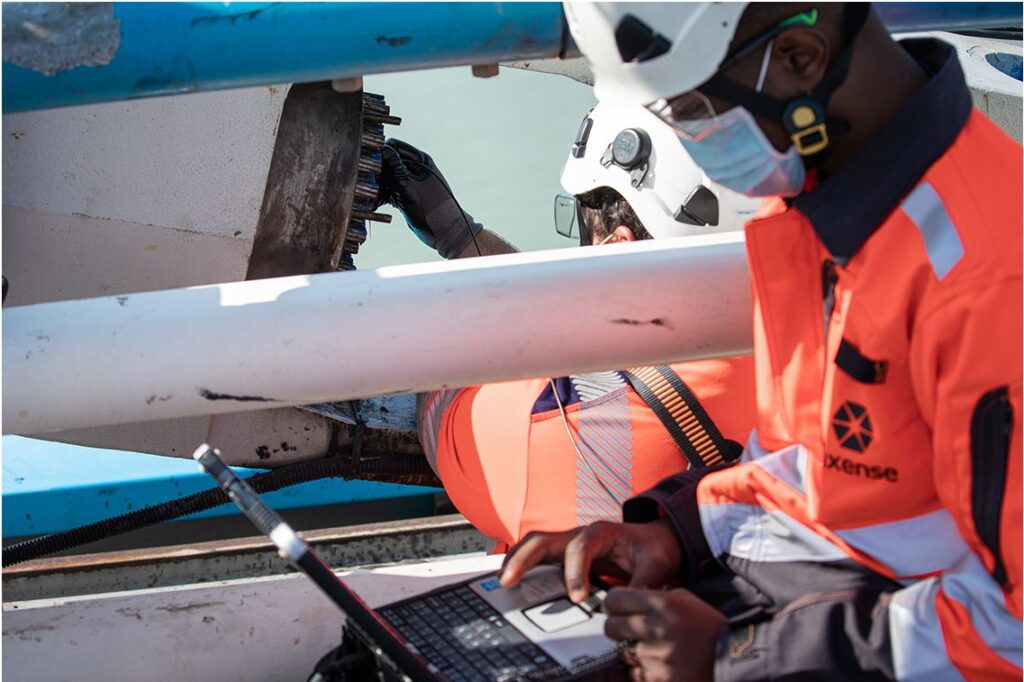
A major high-speed railway project across the UK
High Speed 2 (HS2) Phase 1 is a large high-speed railway project in the United Kingdom which will link London and Birmingham, with a future second phase to reach Manchester and Leeds in Northern England.
This major project will provide increased capacity and reliability of the railway links and should help manage the rising number of passengers.
HS2 phase 1 is expected to open to passengers in 2026 and Phase 2 around 2033.
Sixense expertise applied to this environmentally challenging major project
Sixense is excited to embark on the significant challenge of providing noise, vibration and air quality management services on a section of Europe’s largest infrastructure project, HS2. This section of the mega engineering project, delivered by Align JV, includes the route’s flagship 3.4km-long Colne Valley Viaduct, as well as the 15.8km-long Chiltern twin-tunnels. The services to be provided by Sixense include a significant amount of monitoring, modelling and assessment work across the 10+ worksites, which will play a key role in the wider efforts to minimise environmental impacts throughout the 5-year build.
Sixense teams providing efficient solutions
Within the first six weeks of its involvement, Sixense already installed 22no. noise and air quality monitoring stations, which are largely powered by sustainable-energy sources.
Sixense would like to thank the consortium in charge of the works for their trust on this new project of the Grand Paris Express. The forecast duration of this new contract for monitoring of the works and nearby infrastructures is of 5 years. Line 18 will be about 35 km-long from the Orly Airport railway station to the Versailles-Chantiers railway station.
The market, notified on May 14th of 2020 to the association of several entities of @Vinci Construction and @Spie batignolles, includes the realisation of :
- a bored tunnel of about 11 800 ml, of 7,8 m of effective diameter excluding crossing of structures,
- trenches (cut and covered) of about 850 m between the tunnel and the aerial section comprising the temporary reorganisation of the Croix de Villebois road crossing intercepted by the works,
- structural works of the underground railway stations of Antonypole, Massy-Opéra and Massy-Palaiseau,
- thirteen annexed works, including the connecting branches of the tunnel.
Sixense Monitoring was assigned the auscultations to be carried out in the framwork of the project related to the drilling of the tunnel and to the construction of the infrastructures (excluding Launching shaft and Cut & Cover and excluding inside topography of the railway stations and right-of-ways).
This sector comprises 2 very sensitive areas which will need to be carefully monitored : the important railways nearby the future Massy-Palaiseau railway station and the Orly Airport area.
A permanent Sixense team will remain on the field at the base of the worksite in order to stay as close as possible to the work teams to carry out the mission that we have been assigned to. The team will implement a diversity of auscultation measures, including:
- Automated topographic monitoring with our now well-known Cyclops and Centaurs which will examine the nearby infrastructures of the project,
- Measures by inclinometers of the vertical structures of the infrastructures under construction,
- Stresses and constraints monitoring of the infrastructures under construction or the instrumented voussoirs,
- The geotechnical monitoring of the 16 sections of reinforced measures of the 2 tunnels comprising inclinometers in the field, multipoints extensometers in boreholes and interstitial pressure cells.
Geoscope will be the management support tool for all companies to access all auscultations of the project. This tool had been designed with a multi-actors approach allowing all different parties of the same project to have access to all the useful data : intuitive visualisation of the data, management of the alarms for level exceedances, visualisation of the construction site progression and access to all reports of auscultations.
This project is once again an opportunity for us to implement our monitoring expertise of urban works build up throughout the years with tunnel projects in urban areas where we have been able to step in.
Sissterra, a solution for worksites having an impacting on underground subsoils in restricted environment
Boreholes and other invasive geophysics investigation techniques are not very well adapted and difficult to deploy in restricted environment such as dense urban areas. Having a good visibility of the underground is however always necessary to carry out these works in such spaces.
It’s the reason why our experts developed an innovative geophysics solution, based on seismic without sources and particularly adapted to dense urban areas: Sissterra.
Based on a passive technology, our solution allows to reduce the number of boreholes and avoid active seismic sources. Sissterra passive technique relies on ambient noise recordings in the underground by autonomous geophones, an easy-to-use and easy-to-deploy system on site.
A turnkey and robust solution
An innovation from the academic field and the world of Oil&Gas, Sissterra is a turnkey solution allowing you to have a global visualisation of the underground subsoils. Our experts in geophysics manage the entire data value chain and can advise you from the reflection phase from your geophysics challenges, and this until the risk evaluation, going through acquisition as well. Sissterra is a tool that helps manage risks associated to the underground as it allows to consolidate the geologic model. The global visualisation ahead of the works allow to anticipate the adjustments of the constructive methods to maximise the site productivity.
Discover the solution in video:
Whilst tunnelling using traditional method, the geologists usually carry out regular “manuals” cutting face mappings using a combination of field observation and pictures. But this method is not optimised as the pictures are not “at scale” and are often distorted and therefore, not representative of the actual geometry of the cutting face.
The new photogrammetric solution Pika allows a true and instant 3D reconstruction model of the tunnel face.
The geologist simply takes a few pictures of the tunnel face, then drops off the images on the Sixense Mapping beMap online platform. A Few minutes later, an ortho-image, a 3D map, a point cloud and a mesh are all made available through beMap.
All those files are a true representation of the reality, for both the geometry and the texture.
With Pika, the geologist therefore has access to:
- The lithology and/or the mineralized veins, with real appearance, size and thickness
- The location and the orientation of the fractures and cracks
- The 2D-3D visualisation of all successive tunnel faces, one after another
- The exact measurement of size, distance and surface of anything on the models
Precision, time saving, data storage: Pika facilitates geologic follow ups of excavation works.
Pika is a Sixense Mapping solution.
More information : mapping@sixense-group.com & natacha.robert@sixense-group.com
All the Sixense teams wish you a happy new year! We would like to take this opportunity to thank our customers for their loyalty throughout the past year.
After an atypical year in 2020, we close this chapter on a positive note by sharing with you a quick report of the year, which was nevertheless rich in projects for Sixense.
Follow the highlights of 2020 in the video below from building to underground construction projects, power plant site, bridge digitalisation to the roof of a stadium in the USA.
For more information about Sixense challenges, come and follow throughout the year the projects and highlights of Sixense on our LinkedIn page.
Sixense takes part in writing international monitoring standards
A group of about ten European experts has been working since 2010 on writing international monitoring standards.
Sixense is involved in the project via Martin Beth, director of our Monitoring Division France, by representing France among monitoring specialists from all over Europe, in charge of elaborating European and worldwide standards (CEN and ISO).
Their aim is to help sharing best practices in monitoring, by coordinating and writing them collectively.
Our expert explains :
Each standard takes between 2 and 3 years work in average and we will prepare about ten of them in the following years. The basic standard on general rules was published in 2015, followed by the standards on extensometers, inclinometers, piezometers and pore pressure cells. Our group is currently working on standards for liquid level settlement sensors, strain gauges and load cells and will start working shortly on geodetic monitoring instruments (automatic theodolites for example).
Martin Beth, director of Monitoring Division France, Sixense
Ultrasonic inspection and Acoustic Monitoring of the Ile de Ré Viaduct
The Ile-de-Ré Viaduct in France experienced in 2018 a failure on one of its external prestressing tendons. The bridge owner awarded to Sixense and Freyssinet the mission to secure the structure, inspect ultrasonically the existing tendons, monitoring acoustically their potential failure and replace the broken tendon.
EverSense® Acoustic monitoring and cable replacement are well experienced skills of Sixense and Freyssinet. However, before Ile-de Ré Viaduct, EverScan® ultrasonic inspection of anchorages has only been done on individually sheath waxed strands of stay cables but not on grouted bare strands of prestressing tendons. On prestsressing tendons the risk of failure has clearly been identified and located in the first meter away from the tip of the strand in the anchorage zone, which is further away than stay cables application.
Then Sixense and Gustave Eiffel University (UGE, formerly IFSTTAR) worked on the extension of the ability of the well known ultrasonic USCAN® technology in order to apply it on grouted strand and up to 2 m away from the anchorage.
For this project 85 anchorages have been inspected by USCAN® and 170 acoustic sensors were installed prior to the replacement of the broken tendon. USCAN® measurement resulted in identifying 3 anchorages in bad condition with potential failure. The worst tendon has been removed for replacement. Visual inspection of removed anchorage piece confirmed the blind measurement of USCAN® and showed the ability of the technology to detect failure and corrosion in strands near anchorages.
This emergency job was made in less than 6 months. Today the viaduct is under high acoustic monitoring by Sixense teams for any detection of wires breaking.
Sixense Mapping’s partnership with Topcon positioning Group to expand in africa
As a reference in 3D digitisation of existing assets, Sixense Mapping signs today a partnership with Topcon positioning Group to develop their activity in Africa. The common ambition is to fulfil the needs for digital transformation in the African markets of construction, infrastructures, mines and agriculture.
As an international Group, Topcon is a reference in technologic solutions for constructions such as 3D guidance for jobsite machinery. Topcon is present in Africa through a dense network of reseller, ensuring a busy activity for clients, their projects and local jobsites.
Sixense Mapping just broaden its services offers on one hand, its acquisition solutions by drone, LiDAR on board helicopter or even Mobile Scan already carried out in France and Europe, and on the other hand its data management solutions for a better operational performance:
- Change detection: remotely monitor engineered structures, natural areas (cliffs, vegetation…);
- Exploitation follow up: surfacing project optimisation, monitoring of earthworks, monitoring of quarries & mines.
Dubai is home of some of the most incredible infrastructure and is recognized worldwide for its impressive constructions. Sixense expertise was required for instrumentation and monitoring services at the Ciel Tower project, the highest hotel in the world, currently under construction.
A new iconic tower in the heart of Dubai Marina
Since 2016, an impressive project has risen in Dubai Marina, building the highest hotel in the world. This high-end hotel will include a health club, a luxury spa, a restaurant, 1042 luxury suites, rooftop infinity pools along with other facilities. The Ciel Tower is a new supertall skyscraper of over 80 floors and 365m high. Located directly across the world-famous Cayan Tower (76-floors) on the north side of the marina, the Ciel Tower will become a local memorable landmark with an estimated handover date in 2023.
A complex situation on site
The close proximity with surrounding structures and the congested urban area, including one of the main RTA Marina bridges, brought several challenges to the project. It was indispensable to set an adapted instrumentation and monitoring system during the construction phases.
Sixense provides during the construction early warnings of any excessive and undue movements of adjoining premises and structures and ensures project safety with its 24/7 monitoring system and Geoscope 7 Software, sending information about movements exceeding the expected levels to the required parties. During the excavation phase, settlement, deflection and deformation data were provided in order to verify the initial designs of the permanent structure but also the temporary works supporting the excavation. Eventually, Sixense also monitored ground movements.
Periodic monitoring data reports have been provided to the contractors, consultants and RTA throughout the project.
Zetas, contracted for Enabling Works, entrusted Sixense with the instrumentation and monitoring of the ground and the structures in and around the site. Dutch Foundation, later contracted for foundation changes, recognized Sixense’s track record of delivering success for the project.
Structural Deformation Monitoring of Hampton Roads Bridge-Tunnel Expansion project using AMTS and high precision low cost GNSS.
The $3.8 billion Hampton Roads Bridge-Tunnel Expansion project is the biggest project in the Virginia Department of Transportation history which includes constructing twin bored tunnels west of the existing immersed-tube tunnel and bridge.
Sixense was chosen by the design-build team Hampton Roads Connector Partners (HRCP) (consists of Dragados USA, Flatiron Construction, VINCI Construction Grands Projects and Dodin Campenon Bernard) to perform baseline deformation monitoring of the existing tunnel, approach walls as well as several facility buildings on the south and the north islands connected by the crossing from August 2019 to August 2020.
A robust near real-time deformation monitoring system was designed and implemented using 9 Sixense’s Cyclops automatic motorized total station (AMTS) systems, complemented by nearly 50 novel 4Dbloc, low-cost high-precision GNSS receivers and over 60 wireless tiltmeters.
In recognition of the high quality work performed by Sixense during the 1st stage baseline monitoring, a new contract for transition baseline monitoring into active construction stage monitoring was recently awarded to Sixense, in August 2020, with an expanded scope of monitoring work including a significant amount of AMTS, vibration monitors and other geotechnical instruments.
With 500 m span and its single pylon Komárom bridge is linking Hungary and Slovakia 100 km West from Budapest. Sixense has the mission to design, fabricate and install a full EverSense® Structural Health Monitoring System (SHMS) .
The system includes different type of sensors such as stay cable load sensors, bearing displacement, temperature, video cameras and a weather station with an integrated road surface condition sensors.
The EverSense® SHMS will allow to follow the behavior of the structure, alert in case of abnormal activities and ensure the security of the user.
In a few years the operator of the bridge will use the data generated by the system in order to plan its maintenance and secure the design life of the structure.
Installation of the system went through during the COVID-19 lockdown period which made it more challenging. Thanks to our local entity Sixense Hungary, the installation was made possible despite lockdown with remote assistance from our SHMS experts.
The bridge was inaugurated mid-september 2020.
Sixense’s expertise has been requested on one of Dubai’s community development projects aiming to raise the living standards and services for labour workers with affordable housing and an innovative modern project.
Sixense’s contribution to a large-scale project benefiting to Dubai’s worker community
Located in Dubai’s oldest and most important industrial districts, Jebel Ali Industrial development will provide quality and affordable housing to Dubai’s largest blue-collar workforce.
In the development process and in order to welcome large amounts of residents, a new sewage system had to be put in place under one of the busiest roads, Al Asayel Street. The contractor DX Contracting, hired for this project by MERAAS, opted for a Non-Destructive-Road-Crossing (NDRC) technique using a Micro-Tunnel Boring Machine. Although the machine’s drive diameter is small and used on shallow soils, there is always an existing risk of settlement that must be mitigated.
Sixense implements its innovative reflectorless monitoring technique
Sixense’s client requested the monitoring of the road to observe any vertical movements and mitigate the risk of settlements of this active and busy road under which the new system was being installed.
Usually, most technique consists in installing devices such as optical targets or ground settlement markers on the pavement, an invasive method interrupting traffic and needing a large site organization. Sixense was called to support the monitoring process with an innovative solution.
Sixense’s intervention brought to the project its solution consisting in the installation of a total station, an electronic optical surveying instrument on top of a nearby building, allowing a view of the whole area. From there, the influence area of the Micro-Tunnel Boring Machine could be seen with the reflectorless monitoring system to monitor the road settlements.
This innovative technique was the best solution to monitor the road safely, cost effectively whilst obtaining a density of “instrumentation” of one point every 2m² and allowing to monitor about 200 points. No installations were needed on the road and no traffic needed to be interrupted.
Sixense is aiming to put an end to conventional manual levelling techniques such as classic leveling that require specific traffic management ahead of each reading campaign and questioning safety around traffic environments.
Sixense is proud be involved in this project. Workers will now benefit as well from the area’s excellent connections to Dubai, Abu Dhabi and the northern emirates, Dubaï’s Investment park as well as the proximity to the Expo 2020 site.
Sixense is developing skills in areas with difficult access, including inspection of dam infrastructure.
Destination the “Provençale” region, more precisely the Saint-Victoire Massif close to Aix-en-Provence, where Sixense was called for a periodic inspection mission by the Société du Canal de Provence (SCP), who manages the Zola Dam installations.
Built in 1854 and named after the architect François Zola, father of the writer Emile Zola, the Zola Dam requires periodic inspections and recording of faults on the emerged parts of the structure to assess the state of the dam.
In order to inspect closely the whole surface of the dam at 36m high, our teams carried out the intervention with ropes and harness.
In 2011, a specialist rope access team carried out the inspection alongside our engineer who joined on some of the descents to observe the faults.
But on this recent occasion, and for the first time at Sixense, our engineer, who is also a qualified CQP rope access technician, could carry out a rappelling descent alone. ATOMS provided support in the form of access materials and equipment as well as know-how (anchors set up, descent supervision, presence in case of emergency).
Cédric Laurent, in charge of realisation, is a difficult access specialist at the BEI department:
« the walking trail on the crest of the dam stayed opened during the mission and several different strengthening works down the dam made the intervention quite sensitive. Moreover, the weather conditions and the bushfire risks in the Saint-Victoire Massif meant we could only work from 6am to 1pm. The good preparation of the mission (pre-start site visit, regular discussion with the client, evaluation of the risks…) was a key element for the success of the mission. »
This intervention method allowed us to accomplish quality recordings by an expert inspector, and to optimise the time spent on the jobsite thanks to the reduce number of rope access technician and descents needed.
With dual skills in rope access and in specialist in diagnosis, our Sixense Engineering team can now offer a solution for future interventions on ropes such as inspections, diagnosis, and instrumentation for tall infrastructure where more typical means of access (mobile elevating work platform, scaffolding) are impossible, such as for bridges, stadiums, retaining walls, water towers and chimneys.
Helimap is specialised in precision helicopter-borne LiDAR mapping, with a solid international reputation. The Swiss company, based near Lausanne, established itself on the market thanks to its innovative LiDAR system, adapted to complex terrains and tailor-made applications.
With the acquisition of Helimap, Sixense Group is strengthening its position in 3D capture and modelling technologies for existing assets, a strategic entry point into the digitisation of construction and infrastructure operations. As a result, Sixense is now a leading global player in 3D digitising technologies.
For more information about Helimap’s activity click on the below logo:
We are delighted to announce that a consortium led by Sixense and Imperial College London (with support from experts at Royal Holloway, Crossrail and Thames Tideway) has been selected to produce a CIRIA (Construction Industry Research and Information Association) guidance report on the application of ‘Earth Observation and InSAR technology in civil infrastructure’. This report will draw on the extensive experience of the consortium members and will detail current practices, illustrated with case study examples, and outline respective advantages and limitations of the various techniques to assist all users and, in particular, those involved in asset management and construction. A separate online database of case studies will also be developed in parallel by CIRIA to support the guidance document. We understand that this document will form an important review, of current practices and ongoing developments, to inform newcomers to Earth Observation as well as those already using such technologies.
Civil engineering and infrastructure (construction, maintenance and monitoring) are activities which demand high spatiotemporal accuracy, precision and detail of observations and measurements. Satellite borne remote sensing techniques are now able to produce data and information of a quality which satisfies such requirements. Yet there are few standards and regulations for best practice in the production and use of Earth Observation products. CIRIA has therefore recognised a need to inform stakeholders, to realise the full potential of Earth Observation techniques in both research and commercial operations; hence this guidance report will form a much needed and important step towards establishing the employment of Earth Observation techniques as a matter of ongoing best practice for asset management in all infrastructure projects.
The guidance document will be published in 2021. For more information, please contact satellite@https://middle-east.sixense-group.com
Providing risk management and control throughout the Alaskan Way Viaduct end-of-life cycle
Having suffered earthquake damage, Seattle’s Alaskan Way Viaduct was replaced by the State Route 99 Tunnel. To provide the level of risk control required to carry out this project safely, our local teams installed a total monitoring system for the full 3.2 kilometres of this tunnel beneath the city centre. Four years later, it was joined by another system to monitor demolition of the old viaduct.
Completed on 4 April 1953, the Alaskan Way Viaduct was an elevated double-deck section that carried the State Route 99 above Seattle city centre via the waterfront at Elliott Bay and the city industrial heartland.
The viaduct suffered minor damage in the 2001 Nisqually earthquake, and the following structural inspections persuaded the state and national governments to replace much of the structure with a tunnel beneath the heart of the city.
With a working diameter of 17.5 metres, the world’s largest tunnel boring machine began work on the new State Route 99 tunnel in 2013. The progress made by this super-machine beneath the main landmarks of the city, including Pioneer Square and the Pike Place market, demands an equally impressive risk management and mitigation system.
The highly urbanised environment of this project demanded some very special attention to detail, since existing buildings, engineered structures and utility networks were all exposed to the risks inherent in tunnel excavation.
Controlling these structural and geotechnical risks demanded a wide range of monitoring solutions, including 37 Cyclops (automated monitoring total stations) installed on building roofs and walls, internal geotechnical instrumentation, underground measurement instruments, real-time monitoring managed directly from the TBM control room, and satellite radar interferometry measurements.
All the data gathered are centralised and managed using the Geoscope decision-support platform. Special attention was paid to converting this data into ready-to-use information for individual project contributors. The scale and environment of this project make its monitoring program the most comprehensive ever implemented in the USA.
As an important member of the Alaskan Way Bored Tunnel team, Sixense has provided outstanding technical support, delivered innovative solutions to complex challenges and maintained an unwavering positive attitude.
David Sowers, Deputy Program Director at WSDOT (Washington State Department of Transportation)
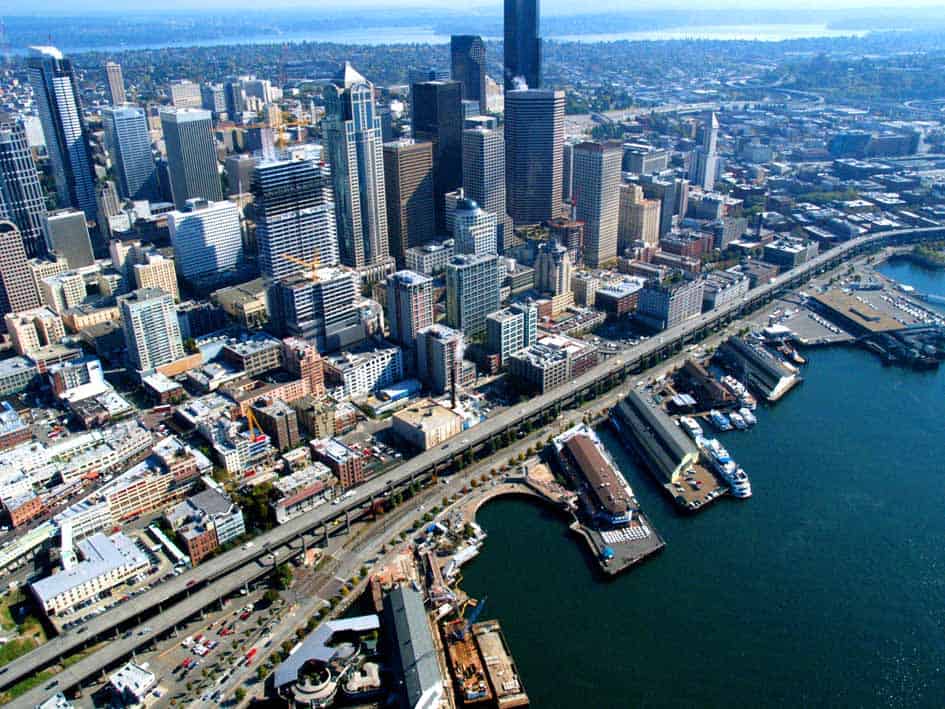
The Rio-Antirrio Bridge in Greece is an exceptionally impressive structure built to endure extreme environmental conditions. Seismic and meteorological risks to its structural integrity must be continually monitored. Its operating concession holder Gefyra has entrusted Sixense with this task for more than 16 years.
From the construction phase onwards, the operating concession holder has needed to monitor the response of the bridge structure to its environment, and validate the assumptions made at the design stage. The ongoing monitoring of the aging structure enables decisions regarding whether the bridge can be reopened or requires maintenance closures following periods of extremely high winds or seismic events.
The Rio-Antirrio Bridge: a structure under the microscope
EverSense ®, our Structural Health Monitoring System (SHM), was designed and implemented by our teams at the time of construction. Since it opened to traffic in 2004, the 1,000 data acquisition channels of this system have enabled Gefyra to record and characterize the behaviour of the structure and to detect changes in this behaviour, especially after exceptional events such as earthquakes or unusually high winds.
The monitoring system has been regularly maintained and upgraded since implementation. It now incorporates functions that enable real-time traffic management during seismic events or exceptionally high winds.
The EverSense system has made it possible to validate structural design data and coupled with the quality of data generated, has made it possible to allow traffic back safely onto the bridge promptly over 16 years of major environmental events.
The real-time monitoring system implemented by Sixense meant that we could analyse the huge amount of data needed to establish an overview of the structure and receive automated alerts immediately after the earthquake struck. The great advantage of the Sixense system is that it allows us to achieve significant improvements in safety, which is the most important thing from our perspective
Aris Stathopoulos, Structural Maintenance Manager at Gefyra SA/ VINCI Concessions for the Rio-Antirrio Bridge in Greece
The world is facing a health crisis of unprecedented scale.
We have the responsibility to protect ourselves and collectively curb the spread of the Covid-19 virus.
Therefore, Sixense teams strictly observe the recommendations of public authorities. In all our activities, we apply the principle of precaution to guarantee the health and safety of our employees, our customers and our partners.
Sixense is a key player in construction services and infrastructure operations. Sixense teams work on infrastructures of strategic importance such as health, energy, personal safety, water, telecoms and transport.
Furthermore, Sixense is committed to serving its customers by providing crucial security services for their sites. We want to reassure all our customers and partners that we are fully mobilized to maintain continuous service within the bounds of what is feasible given the constraints of the current situation.
Our 3 primary concerns / objectives in the countries where we operate are to:
- Guarantee the necessary level of service on all projects required to maintain core infrastructure operations;
- Protect our employees and participate in the collective effort to contain the Covid-19 pandemic;
- Meet our customers and partners expectations by maintaining our services wherever possible.
Our teams remain mobilized to maintain activities. All staff who are able to work remotely have been placed on home office. Your usual contacts at Sixense remain available and ready to listen. In addition, we continue to engage in all daily actions necessary to ensure the proper advancement of our joint projects.
In response to the trust you have placed in us, rest assured of our total commitment and solidarity with you to overcome this extraordinary crisis impacting us all.
Controlling the acoustic impact of a wind farm while minimising the impact on its productivity: that was the challenge faced by our customer Innergex renewable energy.
In response to complaints from local residents regarding noise following commissioning of the wind farm, Innergex decided to take decisive action to ensure good ongoing relations with neighbouring communities as part of its vision to maintain long-term and responsible operational relationships with those living in residential areas around its wind farms. Innergex asked our acoustics experts to develop a methodology specific to this wind farm in order to provide an objective assessment of its acoustic impact in the context of current regulations, and to prepare an effective and optimised noise limitation plan that would deliver guaranteed outcomes.
Our teams then set to work on helping Innergex to resolve this sensitive issue of noise. For this project, our brief was to bring forward a solution that was acceptable to everyone involved, at the same time as meeting Innergex productivity goals for its wind farm. A series of conversations between Innergex and Sixense resulted in the emergence of a completely new study methodology designed to quantify residual noise levels, while maintaining almost full operation of the generators throughout the measurement campaign.
In estimating the overall acoustic impact of the wind farm and establishing a suitable noise reduction plan, our acoustics experts used a range of different techniques, including measurements during full-power operation of the wind turbines and noise decay measurements in close proximity to the turbines to avoid the influence of weather conditions. These measurements made close to the turbines were supplemented by measurements taken at the homes of local residents to ensure perfect calibration of measurements and calculations.
In this way, our engineers were able to develop an optimised noise reduction plan consistent with the current options for programming wind turbine operation. They were also able to contribute to the development of noise reduction options to reduce the intrusion perceived by some local residents. The results achieved following adoption of the noise reduction plan proved fully consistent with the results predicted by the simulations conducted by the acoustics engineers.
The comprehensive nature of this study has given Innergex a high level of control over the acoustic impact of its wind farm and has helped to improve the dialogue and relationship between the wind park and local residents. Based on these successful outcomes, Sixense has applied a similar methodology in a second Innergex wind farm.
We particularly appreciated the professionalism and responsiveness of Sixense, the reliability of the equipment used and the high quality of technical interaction at every stage of these acoustic studies, right through to the submission of reports
Vincent Remillon, Manager France Construction and Operation at Innergex
We have supported Nordex wind farm development projects since 2003 through our involvement in developing the noise component of the environmental impact assessment package for its projects. This long-term partnership has developed throughout our collaboration on more than 50 projects all over france. Now is a great opportunity to look back on this special relationship and the way we operate.
All wind farm projects in France must meet particularly strict regulatory criteria, including the environmental impact study that acts as the basis for consideration of all applications to operate a wind power generating facility. The study is required to demonstrate that the project can be integrated sensitively into its environment, and that the potential impacts of the future wind farm are both managed and controlled.
Noise pollution is a major element of such an impact study. France has some of the most restrictive regulations in the world, requiring wind power projects to comply with a noise emission criterion based on residual noise: the base noise level prior to construction of the project, as measured at the dwellings closest to the future wind farm. A predictive acoustic impact study is then prepared as the basis for estimating the emergence levels (the difference in noise levels with and without wind generators in operation) and providing local authorities and communities with guarantees that the project will comply fully with all applicable rules once it becomes operational.
As acoustic engineers, our priority is to provide an objective and robust study that will enable the wind farm developer to prepare its operating strategy and strike precisely the right balance between power generation and regulatory compliance.
A standard study therefore includes pre-construction residual noise level measurements taken over several weeks, which will serve as the current benchmark level. There then follows the use of a predictive model to forecast the level of noise generated by the future wind turbines. Operating scenarios prepared in consultation with Nordex on the basis of reducing turbine noise levels in different weather conditions are then studied to ensure that the project complies fully with all regulations.
As these projects have advanced, so we have been able to develop our techniques in a number of ways: examples include systematic preliminary visits to all study areas before beginning any campaign to measure the initial noise landscape. The purpose of such visits is to identify the most representative measurement locations and to agree arrangements with local residents before installing our sensors.
The relationship between Nordex and Sixense is much more of a partnership than simply a customer/supplier relationship. The long-term involvement of Sixense in our projects and its excellent understanding of wind farm noise gained from practical experience in the industry mean that Nordex can be certain that the acoustic studies it includes in the impact assessments for its development projects are both robust and comprehensive. The primary goal of the acoustic study is its acceptance by the regulatory authorities, and the feedback we have received from these authorities tells us that the studies produced by Sixense are appreciated not only for their technical and scientific content, but also for their clarity.
As a wind farm developer rather than an operator, it’s important that Nordex obtains the most reliable acoustic measurement results in order to estimate how wind farms should be operated to maximum advantage. So we have to anticipate the possible noise reduction measures to be applied prior to their commissioning. In practice, these noise emission reductions impact the generating output of the project. These issues are relevant, because it is important that the customer ultimately responsible for operating the wind farm has no nasty surprises as a result of underestimating the impacts of the project, at the same time as avoiding the pitfall of devaluing a project by overestimating the risks involved and recommending excessively stringent constraints that will negatively affect the forecast generating output.
From our prospective as a wind turbine manufacturer, the expertise and involvement of Sixense helps us to develop our wind turbines in ways that can take maximum advantage of the operating conditions recommended by Sixense. The issues around the specific impact of wind parks during the particularly sensitive evening period can now be effectively addressed by the wind turbines we produce. In return, our special expertise as a turbine and wind farm developer undoubtedly helps Sixense to continuously improve its knowledge of wind energy technology and related issues.
Quentin Crespel, Acoustics Expert at Nordex France SAS
Using vibration to measure the tension in the cable stays of the MOHAMMED VI bridge in Morocco
At 950 metres in length, the Mohammed VI bridge remains the largest cable-stayed bridge on the continent of Africa. For this type of bridge, cable-stay tension must be adjusted throughout the construction phase to balance the stresses in the bridge deck; in this case, the contractors used hydraulic jacks. Following completion, an additional series of tension measurements were required. Having commissioned the structure, the Chinese contractor Cover-Mbec appointed Sixense to conduct a campaign to measure the tension in each cable-stay using vibration techniques.
Traditionally, hydraulic jacks would be used to take these measurements which entails expensive resources and immobilizes significant sections of the structure for extended periods. The alternate vibration method utilized by Sixense measures the vibration frequency of cable-stays, which provides a direct relationship to their static tension. In practice, accelerometers are attached to the cable-stays and oscillated for a short period.
For this project, the only resources required to perform the vibration measurement were a single work cradle and vibration analysis kit. As a result, only one lane of traffic needed to be closed for the work to be carried out successfully. The tension in all 160 of the bridge’s cable-stays was measured this way, and the report delivered on time.
This is our largest cable-stay tension measurement campaign to date, and the local team was supported by just-in-time data analysis by colleagues in France. This allowed us to optimise the measurement report delivery lead time and meet the deadlines set by our customer”
Quentin Common, Project Manager at Sixense
